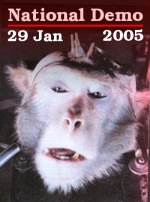STOP THE OXFORD ANIMAL LAB, meet 12.30pm, Broad St, outside Balliol college, Oxford, OX1 3BJ.

The only way the pharmaceutical industry is going to seriously look into alternatives to using animals in testing new drugs is if they are forced to. It's up to the animal rights movement to, if necessary, drag them kicking and screaming into the 21st century. At the moment too many influential people prosper from the use of animals used in vivisection, from the shareholders of the multinational pharmaceutical companies, through to the animal breeders, cage and food suppliers, down to the vivisectors and animal technicians themselves. Even those building contractors who see a fast buck in building new labs are all keen on holding onto an outdated mode of testing. Whether it works isn't something that interests them. At the end of the day, it's about their profit margins and the fact that it works for them is all that matters.
--------------
National Demo, Sat 29th January 2005
In the last week Oxford University have made statements to the effect that work will resume on the half-built animal lab on South Parks Rd in Febuary. Statements from the university hierarchy to the media insist that the animal torture lab will be completed by late 2005 and no one will stand in their way. Oxford University is an institution that is used to getting its own way even if that means misusing its power and influence to silence those with a legitimate right to question its motives.
What is also alarmingly true is the fact that those involved in abusing animals inside its labs are shielded from investigation by a culture that has grown in the rarified atmosphere of Oxford University. Oxford University repeatedly tells the outside world that it's an institution that upholds the principle of 'Free Speech', unless of course you are someone who dares to question the so-called scientists conducting experiments on animals inside the university labs, then you suddenly become an 'extremist' or 'terrorist'. During November 2004 Oxford University gained an injunction against SPEAK which restricts the campaign to one demonstration a week outside the building site and places severe restrictions on what can be placed on the website, if ever there was an attack on 'Free Speech' then Oxford University are at the vanguard and one must surely ask the question, who are the real extremists?
Oxford University scientists are daily subjecting animals to pain and suffering and the university's attempts to construct another animal lab are not as they have tried to tell the media "a rationalization of existing animal research facilities" but an expansion that will mean thousands more innocent animals becoming the "assets" that one Oxford professor recently described a monkey as being. These so-called assets are thinking feeling creatures with their own personalities and curiousity-driven approach to the world around them, but in the case of the animals inside Oxford University this will be denied by academics whose only interest lies in the publication of another useless research paper or pandering to the mighty pharmaceutical industry.
Oxford University have made claims that it is at the 'cutting edge' of medical research but a look at some examples of this research tells a very different story. The details of an experiment published in Nature in 2002 decribes how ten five week old kittens had the eyelids of one eye sewn together, the kittens also had parts of their skulls removed in order to expose the brain. No conclusion was provided for this experiment other than to explain why this study appeared to contradict a similar experiment carried out on monkeys.
In another experiment published in the 'European Journal of Neuroscience, 2004', Oxford University scientists carried out an experiment on two Rhesus monkeys. These sentient beings were fitted with head restraints and a recording chamber fitted over part of the brain that had been exposed to allow recording of brain cell activity. During the experiment the monkeys were positioned in a primate chair with their heads forcibly restrained. They were required to fixate their vision on different patterns, in addition, the monkeys had to press and release a lever in a very short period of time in exchange for water reward. Giving the monkeys small amounts of water as a 'reward' would suggest that they were deprived of water before the experiment. This pointless experiment conducted by academics at Oxford university and was part funded by the U.S. Air Force Office of scientific research and European office of aerospace research and development.

 Homepage:
Homepage: